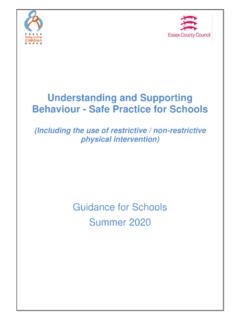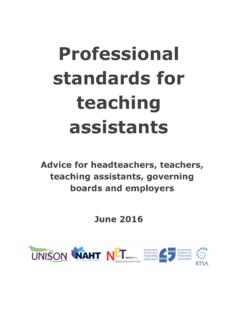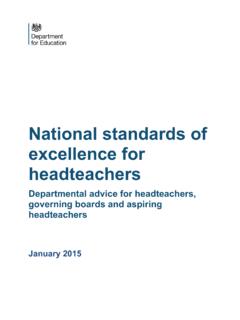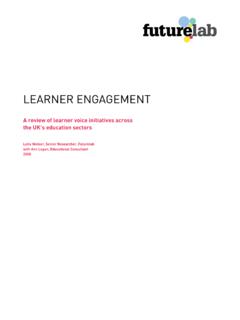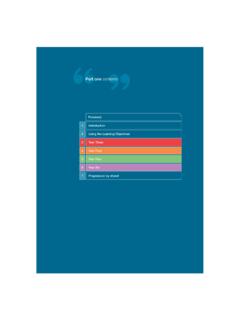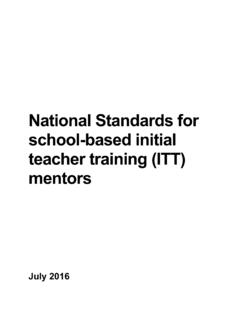Transcription of Essex Banding Descriptors Matrix Explained
1 1 of 5 Essex Banding Descriptors Matrix Explained Essex Banding Descriptors Matrix Explained Introduction Banding Descriptors have been used in Essex for many years to support a fair and equitable distribution of resources for statutory plans relating to special educational needs (SEN). Following changes to the national curriculum, with the removal of levels and the introduction of the Children s and Families Act 2014 the Banding Descriptors needed to be updated. The Banding Descriptor Matrix has been developed to create the system the Local Authority (LA) will use to allocate element 3 top up pupil led funding to each Education Health and Care plans (EHCP) with effect from September 2017 for all new EHCPs. For more information about when a child requires and EHCP please look on the Essex Local Offer. Information obtained as part of the EHC needs assessment will be triangulated with the views of professionals who know the child to identify a best fit on the Matrix . This will then provide an indication of the amount of money that will be needed for the required provision, as set out in the EHCP designed to meet the child s SEN.
2 As well as updating the previous system the Banding Matrix will also enable larger sums of money to be allocated to children with the highest needs within Essex provision. This supports the Local Authorities strategy to increase the range of provision in Essex and provide a school an Essex school place for every Essex child. For pupils who already have an EHCP the LA will use information provided by schools, as part of the pupil s annual review, to identify the band ready for the next phase of education. This will occur at every Key Stage change for all EHCPs from September 2017. In addition a move in to or out of special education will also require the process of Banding to be completed using information obtained from the school as part of the review of the placement. How was the Banding Matrix developed? The Banding Matrix was developed following a review of the systems used by other LAs. Specialist Educational Psychologists, Specialist Teachers, Headteachers (from mainstream, special schools and enhanced provisions), SENCOs, representatives from the Schools Forum and members of the Statutory Assessment Service, standards and excellence and Provision Development teams have been involved in the development of the Banding Matrix .
3 The Matrix has been tested by schools and the LA. All feedback 2 of 5 Essex Banding Descriptors Matrix Explained obtained as part of the pilot phases has been considered and has informed updates to the Matrix . How to use the Banding Matrix ? The Matrix is split into 4 main areas in line with the SEND Code of Practice 2015. Each section is then split in to subsections Sensory and or Physical Physical Difficulties and independence skills Hearing Vision Communication and interaction Speech and language Social communication and Autism spectrum Social emotional and mental health Emotional Wellbeing and Social Behaviour Learning Behaviour and attitude Cognitive and learning Learning Difficulties The needs in each subsection are described in levels (rows). Level 0 represents no needs over and above that which you would expect in a typically developing child to Level 6 which represents the highest level of need. The levels 0-6 are hierarchical within each subsection (columns) but beyond row 1 there is no direct relationship between the Descriptors across the subsections (rows) for each level.
4 A weighting system has been used to acknowledge the relationships between each subsection of need. Level 0 represents the level of need that can be met with the Key Stage Funding element 1 funding, previously known as age weighted pupil unit (AWPU) Level 1 represents the level of need that can usually be met from the 6000 national funding known as element 2 additional support funding which is available without an EHCP, and comes from the Schools block Level 2 upwards represents the element 3 pupil led top-up funding which comes from the high needs block. 3 of 5 Essex Banding Descriptors Matrix Explained Each square on the Banding Matrix has then been allocated a point score with a weighing to reflect the impact that the described needs will usually have on the provision that will be required. To complete the Banding Matrix a teacher, Educational Psychologist (EP) or LA Officer will identify the level in each column which best describes the child s needs. A best fit approach is used.
5 This is repeated for each subsection in each column. Even when there are no needs level 0 should be recorded. A Banding Matrix Summary Form should be completed by the teacher (in school and Specialist Teacher, if involved) Educational Psychologist (EP) as part of the assessment process and submitted to the Local Authority (LA) along with their statutory advice for the EHC needs assessment. Once the LA has agreed to issue an EHCP (this decision is taken after the Outcomes Meeting) the LA officer(s) will complete the Banding Matrix based on the content of the plan and the appendices and then cross reference with any other Banding summary forms received as part of the assessment. The LA will then make the decision about which band should be allocated using all the information available. The Excel version of the Banding Matrix used by LA Officers will indicate the band associated with the score. Each band relates to different financial sum. here are 10 bands each representing a different financial value.
6 The overall amount of money available in element 3 top-up funding remains the same in Essex . The system aims to secure a more accurate sum for each pupil s needs. Some pupils might receive more money and some might receive less. These values are on top of the 6000 in element 2 funding already in the school. The Banding Matrix cannot describe the needs of every child and therefore it is essential that the score achieved using the Matrix helps direct a conversation in the LA about resources to meet the needs of the child taking account of all the information from the draft EHCP including the specified provision and the views of professionals who know the child. The Matrix is not to be used to achieve a definitive answer. Band 0 0 Band 1 1,800 Band 2 2,700 Band 3 4,800 Band 4 7,500 Band 5 10,000 Band 6 15,000 Band 7 20,000 Band 8 25,000 Band 9 30,000 Band 10 40,000 4 of 5 Essex Banding Descriptors Matrix Explained Frequently asked questions How does the age of the child affect the Banding Matrix ?
7 The age of the child is important when considering the needs of a child. For example, the level of attention to task that can be expected will be very different for a 6 year olds and 16 years old. The Descriptors in the Matrix make reference to other children of a similar age. So when you make your judgements regarding needs that is the measure you should use. How were the weightings determined? The weightings have been determined through the piloting phase based on the relationship between columns. Who completes the Banding Matrix ? Schools and any LA professionals who know the child will be asked to send in their views on the needs of each pupil who has had EHC needs assessment or who has an EHCP and is moving Key Stage or moving between mainstream and special school. The LA/EHCP panels will then consider this information and all the evidence available to identify the band using the Matrix . The decision will be made through a discussion and is not just determined once the Matrix is completed.
8 When is the Banding Matrix completed? Schools will be invited to complete the Matrix as part of a new EHC needs assessment and they can submit a Banding Matrix Summary Form with the advice they send as part of the EHC needs assessment or Annual Review. The Matrix is not a tool to determine if an EHC needs assessment is required so should not be sent with a request for an EHC needs assessment. EPs and Specialist Teachers who write advice as part of an EHC needs assessment will be asked to submit a Banding Matrix Summary Form when they submit their statutory advice. The LA will allocate a band using all the information they receive at the point of a draft EHCP which is issued after the Outcomes Meeting. 5 of 5 Essex Banding Descriptors Matrix Explained What if the school or parents disagree with the amount of money allocated? The decision about which band to allocate will be taken using the information provided as part of the EHC needs assessment or the Annual Review. This will include the school s and parents views.
9 In addition, schools will be invited to submit their views about the pupil s needs as described on the Banding Matrix . The LA will base its decision on the evidence provided. If the school or parents disagrees then the first step to resolve this would be for the school staff to have a conversation with the Statutory Assessment Service team in the area. Parents and schools retain the right to SEND Tribunal when a new EHCP is issued. How often will the EHCP be banded? The Banding Matrix will be gradually introduced through 2017 with all new EHCP from 1 September 2017 banded using the Matrix . Existing plans which have not been banded using the Banding Matrix will be banded using the Matrix at the point of a move to a new Key Stage or if the pupil is moving to a new setting. How often will the Matrix be reviewed? The content of the Matrix , the weightings and the financial values associated with each band will be reviewed annually. There will be a feedback loop for all users of the Matrix to provide their views.
10 Can schools use the Banding Matrix to help identify the cost that should be charged to other LAs when a pupil moves in with an EHCP hosted by another LA? Yes, the Matrix can be used by schools to support them as seen as appropriate and helpful. Links to resources The Banding Descriptors Matrix (Excel version) Guide for using the Banding Descriptors Matrix : Guidance for setting The Banding Matrix Summary Form



